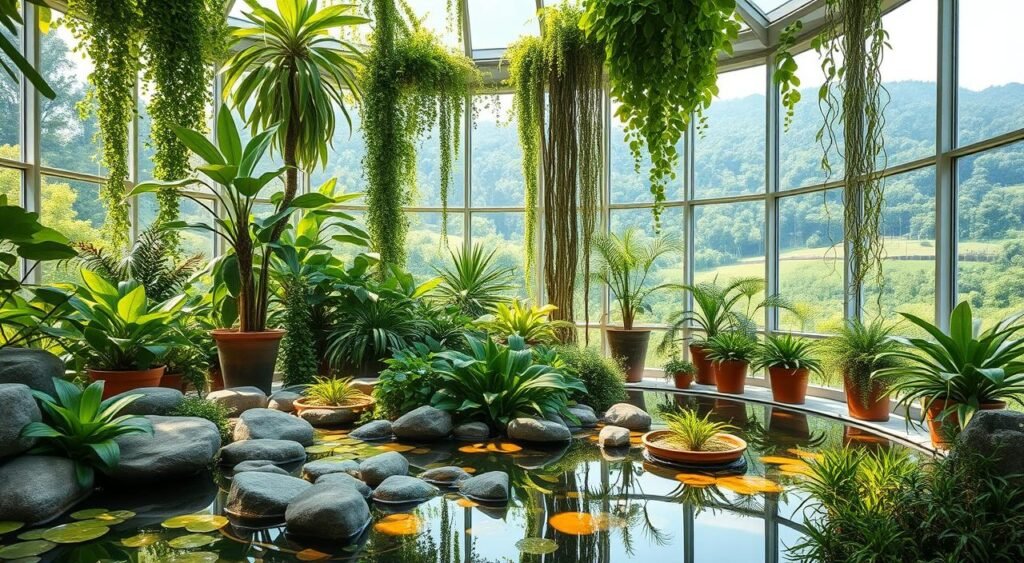Ever thought how a simple plant or a bit of natural light could turn your home into a peaceful sanctuary? In today’s fast-paced world, biophilic design offers a refreshing escape. It brings natural elements into our indoor spaces. By adding greenery, large windows, and organic materials, you can make serene living environments. These spaces promote well-being and calm.
This article will show you practical strategies for bringing nature indoors. We’ll cover choosing the right indoor plants to using natural materials. We’ll also focus on budget-friendly options. Whether you’re planning a renovation or just want to improve your decor, learning about biophilic architecture can help. It can turn your home into a peaceful oasis. For more on nature-inspired design, check out this resource.
Key Takeaways
- Biophilic design enhances indoor environments through the incorporation of natural elements.
- Indoor greenery plays a vital role in improving air quality and aesthetics.
- Natural light can significantly boost mood and productivity levels.
- Using organic materials creates a cozy atmosphere that connects you with nature.
- Budget-friendly strategies make biophilic architecture accessible to everyone.
Understanding Biophilic Design
The definition of biophilic design highlights the need to merge nature into our daily spaces. This philosophy is rooted in our innate connection to the outdoors. It seeks to leverage this emotional tie. By incorporating plants, natural light, and organic materials, we craft environments that are not just visually pleasing but also boost our emotional and mental health.
The importance of biophilic design is profound. Studies show that spaces rich in natural elements can lower stress, improve concentration, and spark creativity. As you ponder your environment, remember how biophilic design can turn it into a haven that aligns with your life and tastes.
In the realm of biophilic interior design, we’re talking about applying these principles in homes and offices. This might involve placing plants by windows, choosing furniture made from natural materials, or designing spaces that welcome plenty of light. Every decision we make helps create a peaceful, nature-connected environment.
Benefits of Biophilic Design for Your Well-Being
Adopting biophilic design can revolutionize your living environment. Studies show that natural light and indoor plants boost mood and focus. This connection to nature brings a sense of calm, reducing stress.
Biophilic design enhances well-being by promoting relaxation and creativity. The air quality from plants improves, contributing to better physical and mental health. These elements not only enhance your space’s beauty but also support a more balanced life.
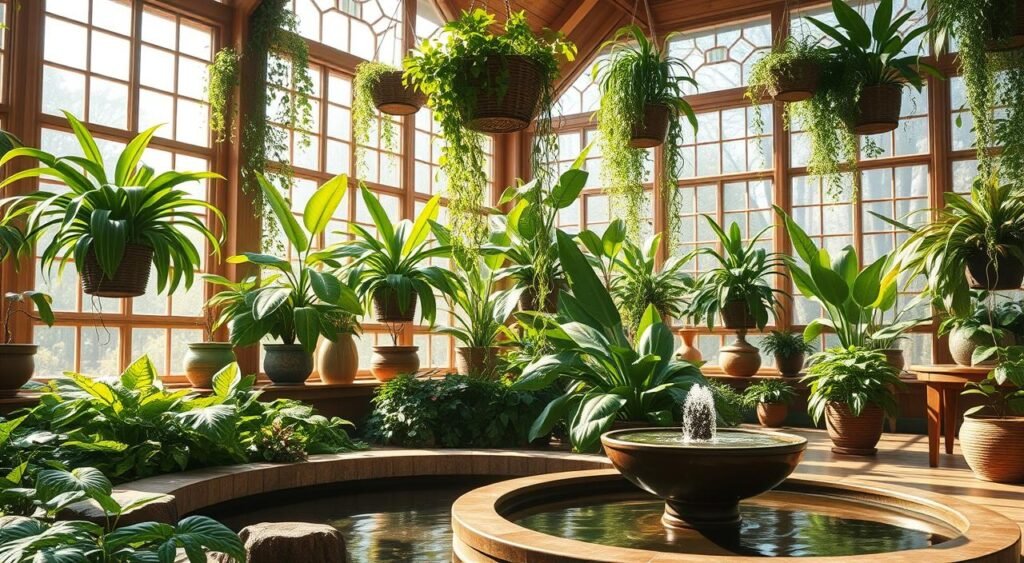
Key Principles of Biophilic Design
Biophilic design is about bridging the gap between indoors and outdoors. It focuses on blending natural elements into your living space. A key principle is to maximize natural light, bringing in sunbeams that warm and welcome you.
Using organic textures and materials is also vital. Picture walking on wood floors or touching stone countertops. These elements enhance your space’s beauty and foster a sense of calm, making you feel connected to your surroundings.
Creating spaces that echo the outdoors is another cornerstone of biophilic design. Think of indoor gardens or open layouts that merge your living area with nature. This multi-sensory experience boosts your well-being, engaging sight, sound, and touch.
By embracing these principles, your home becomes a sanctuary for both body and mind. Every detail contributes to a serene atmosphere, allowing you to relax and appreciate nature’s beauty.
How to Incorporate Plants into Your Space
Bringing nature indoors can be incredibly rewarding. Enhancing your living space with plants creates a vibrant atmosphere. From choosing the right indoor plants to designing vertical gardens, nature-inspired decor can elevate your home’s aesthetic and ambiance.
Choosing the Right Indoor Plants
The selection of indoor plants is key. Opt for low-maintenance options that thrive in various lighting conditions. Here are some favorites:
- Snake Plant: Known for its air-purifying qualities and resilience.
- Pothos: A trailing plant that can adapt to different light settings and is very forgiving if you forget to water it.
- Fiddle Leaf Fig: Adds a touch of elegance with its large, glossy leaves, and loves bright light.
These plants not only enhance your green decor but also promote a healthier living environment.
Creating a Vertical Garden
Vertical gardens can transform any wall into a living masterpiece. This approach saves space and provides a stunning visual impact. Imagine lush greens cascading down an empty wall, bringing tranquility to your space. To get started, consider using:
- Wall-mounted planters for space efficiency.
- Self-watering systems to simplify care.
- A variety of plants for visual contrast—herbs, succulents, or flowers can all harmonize beautifully.
Vertical gardens serve as a natural focal point, inviting peace and connection to the environment.
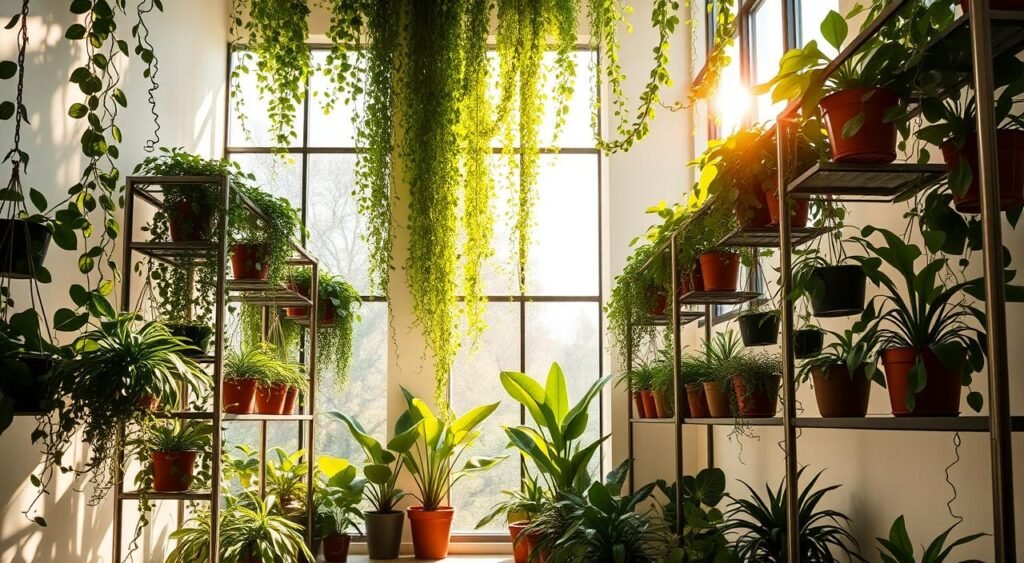
Utilizing Natural Materials for a Cozy Atmosphere
The choice of materials in your living space greatly affects the coziness of your home. Using natural materials like wood, stone, and bamboo brings warmth and texture. This creates an inviting atmosphere, much like being outdoors. These elements not only beautify your space but also reflect a genuine, biophilic design.
Incorporating Wood, Stone, and Bamboo
Wood brings a timeless elegance to interiors, with its rich veins and varied finishes. It can be used in furniture, flooring, or as accent pieces, adding comfort and natural charm. Stone, often seen in countertops or decorative elements, offers durability and sophistication. Bamboo, known for its eco-friendliness and style, is ideal for those who value sustainability. I suggest looking into minimalist decor ideas that incorporate these materials harmoniously.
The Role of Textiles in Biophilic Design
Textiles are essential in making your space cozy. Choosing biophilic textiles made from organic fibers, like linen or cotton, boosts comfort and enriches your home’s feel. Adding these materials, such as linen drapes or woven throws, creates a layered texture that encourages relaxation. Each fabric choice complements your natural decor, deepening the aesthetic and fostering a peaceful environment.
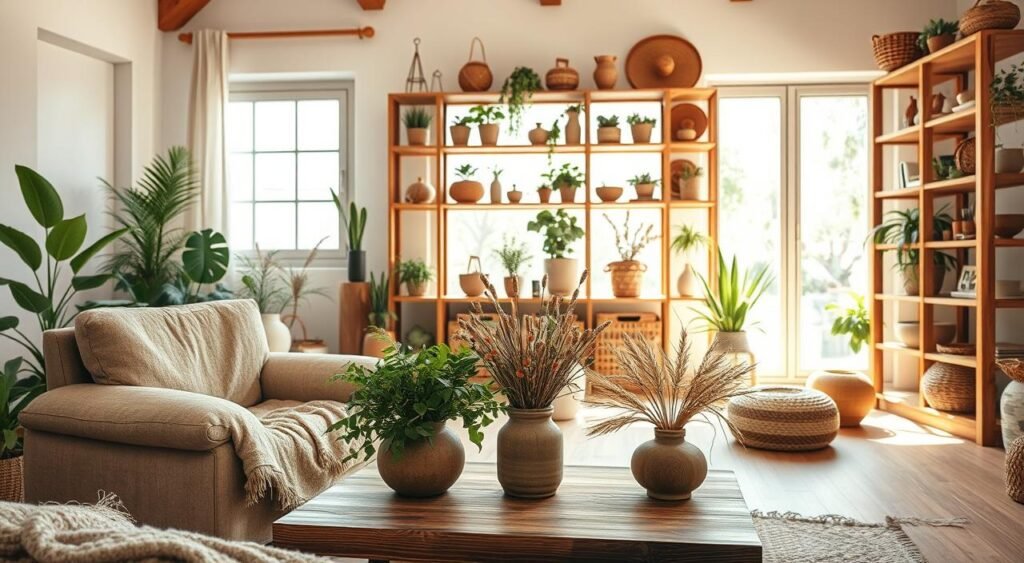
Maximizing Natural Light to Enhance Space
Embracing natural light in design is key to creating a welcoming atmosphere. It not only improves mood but also significantly enhances indoor light. Here are effective strategies to open up your space and expertly leverage sunlight.
Strategies for Opening Up Your Space
- Install large windows or skylights to flood rooms with vibrant light.
- Opt for sheer curtains that elegantly diffuse sunlight, maintaining privacy while allowing brightness to flow in.
- Arrange mirrors in strategic locations to bounce natural light around, amplifying its effect.
- Choose light-colored walls and furnishings that reflect and beautifully enhance indoor light.
Lighting Systems that Mimic Natural Light
When natural light is scarce, advanced lighting systems become essential. Systems like Philips HUE produce warm tones that mimic daylight. This not only enhances aesthetics but also aligns with your body’s natural rhythm. Transitioning to these innovative solutions can harmonize with your design goals. For more on effective design strategies, visit this informative guide.
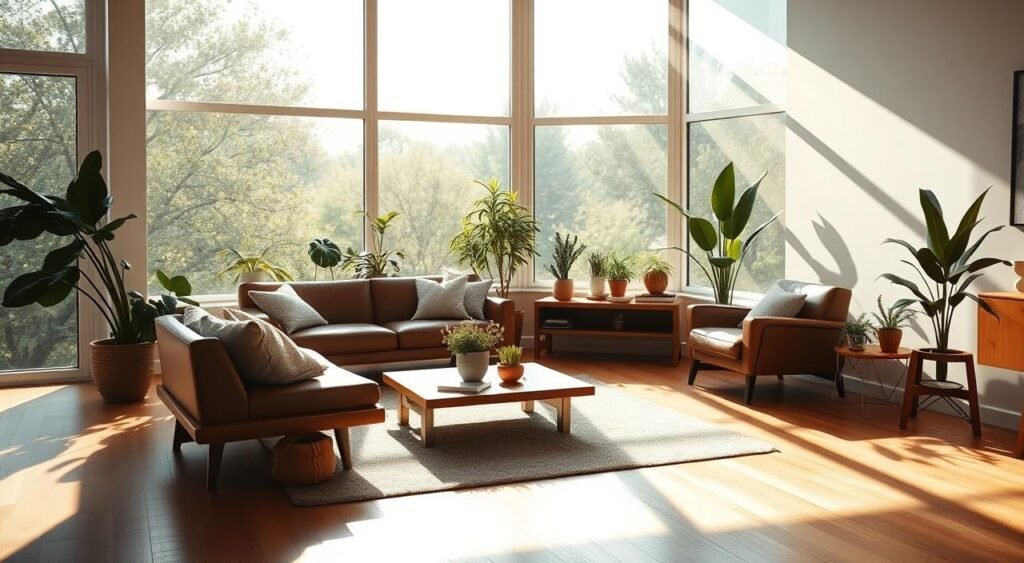
| Light Source | Effect on Space | Best Usage |
|---|---|---|
| Natural Light | Brightens and expands spatial perception | Daytime ambiance |
| LED Warm Light | Creates a cozy atmosphere | Evenings and nighttime |
| Task Lighting | Enhances focus and reduces strain | Work areas, reading nooks |
| Accent Lighting | Highlights features or decor | Artwork, plants |
Adding Water Features for Calm Vibes
Water features in design offer a unique mix of beauty and tranquility. Picture stepping into a room where the soft sound of water instantly eases your tension. Whether it’s a small tabletop fountain or a grand wall-mounted piece, these elements can turn your space into a serene retreat.
Adding water features to your decor promotes relaxation. The constant flow of water mimics nature, providing a calming sound. This can boost focus and help you relax after a busy day.
Consider these popular types of water features:
| Type | Description | Benefits |
|---|---|---|
| Tabletop Fountain | A small-sized fountain ideal for desks or tables. | Compact design, easy to maintain, creates a soothing environment. |
| Wall-Mounted Waterfall | An artistic feature that attaches to the wall, cascading water downward. | Space-saving, enhances vertical design, adds luxury ambiance. |
| Indoor Pond | A small pond installed within your space. | Supports aquatic plants and fish, creates a serene natural atmosphere. |
| Self-Watering Planters | Planters that integrate an internal water feature. | Ties together plant life with minimal upkeep, encourages greenery. |
Integrating these water features shapes your home’s atmosphere. As you explore calming home decor, remember that water’s soothing sounds are key to creating a peaceful sanctuary.
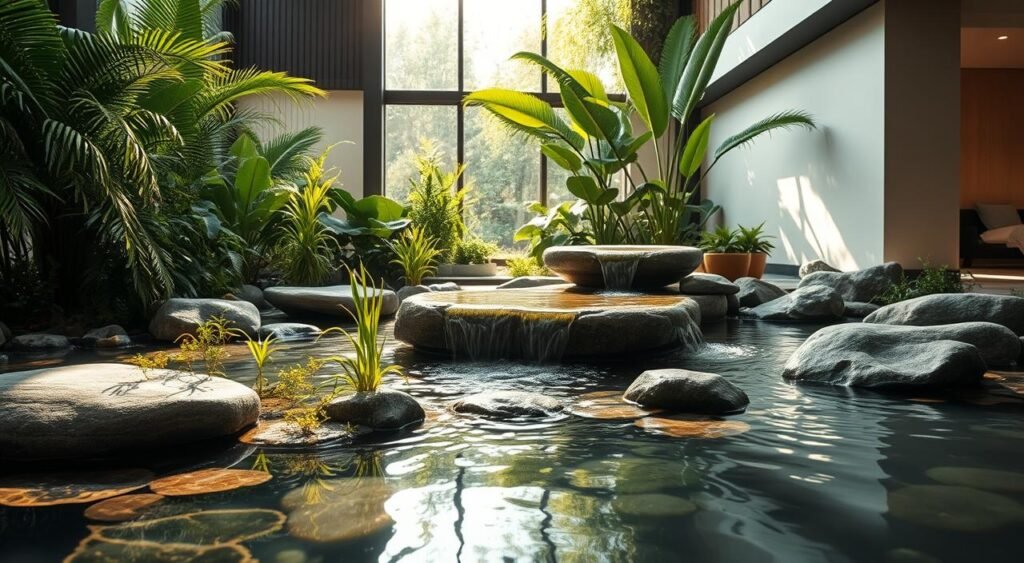
Biophilic Design in Different Rooms
Transforming your home into a serene sanctuary is achievable through room-specific biophilic design. Each room presents unique opportunities to connect with nature. This approach enhances both aesthetics and well-being.
Transforming Your Living Room
The living room is the heart of the home. Enhance this space with living room plants like snake plants or fiddle-leaf figs. These plants add vitality and color, improving air quality. Opt for light-colored fabrics, such as linen curtains and velvet pillows, to complement natural light and boost comfort.
Adding a textured wool throw brings warmth, encouraging relaxation and coziness.
Creating a Biophilic Kitchen
In the kitchen, biophilic design tips are key for a fresh, lively atmosphere. Introduce potted herbs like basil or rosemary for beauty and flavor. Succulents thrive in light, adding visual interest. Use reclaimed wood for shelving and recycled glass containers to promote sustainability and enhance the organic kitchen feel.
For more on using natural materials, explore these practical tips.
Designing a Peaceful Bedroom
The bedroom should be a tranquil retreat. Choose calming colors and soft textiles for a restful environment. Select air-purifying plants like peace lilies or spider plants for better sleep and peace. Incorporate natural textures, such as cotton or linen bedding, for comfort and relaxation.
A balance of plants and soothing fabrics turns your bedroom into a sanctuary.
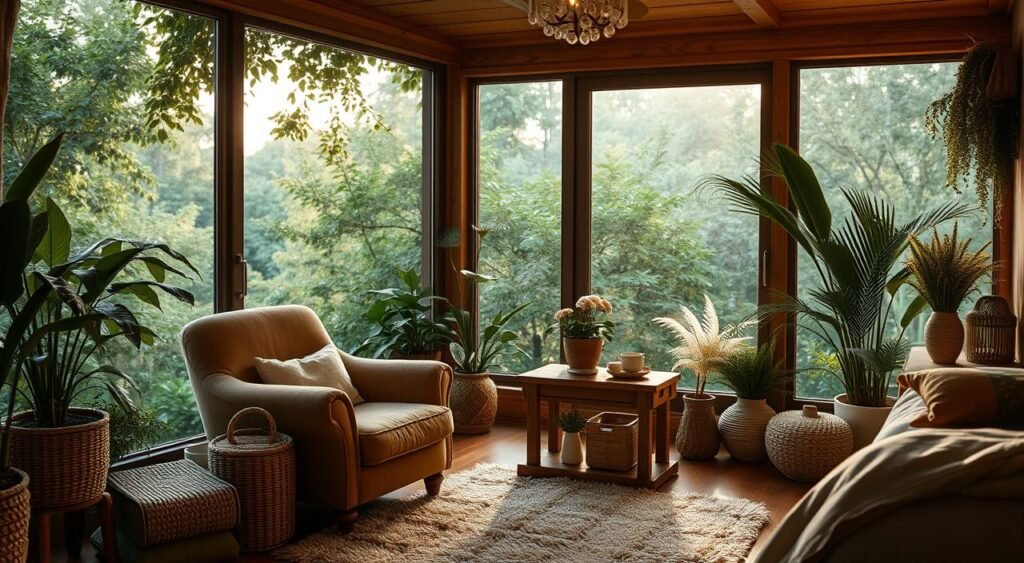
Incorporating Nature-Inspired Art
Art is essential in creating a space that feels connected to nature. By choosing pieces that reflect the outdoors, you can enhance your environment. Consider framed botanical prints or abstract landscapes that showcase nature’s beauty.
When picking art for a biophilic design, focus on organic shapes and earthy colors. These elements not only beautify your space but also bring a sense of calm. Artwork that mirrors nature’s tones and textures can strengthen your home’s theme.
Here are some tips for choosing nature-inspired art:
- Look for local artists who specialize in nature-themed pieces.
- Choose artwork that complements your existing decor while adding a touch of the outdoors.
- Experiment with different mediums, such as paintings, photography, or sculptures, to provide variety.
Incorporating these elements can truly bring the serenity of nature into your living spaces!
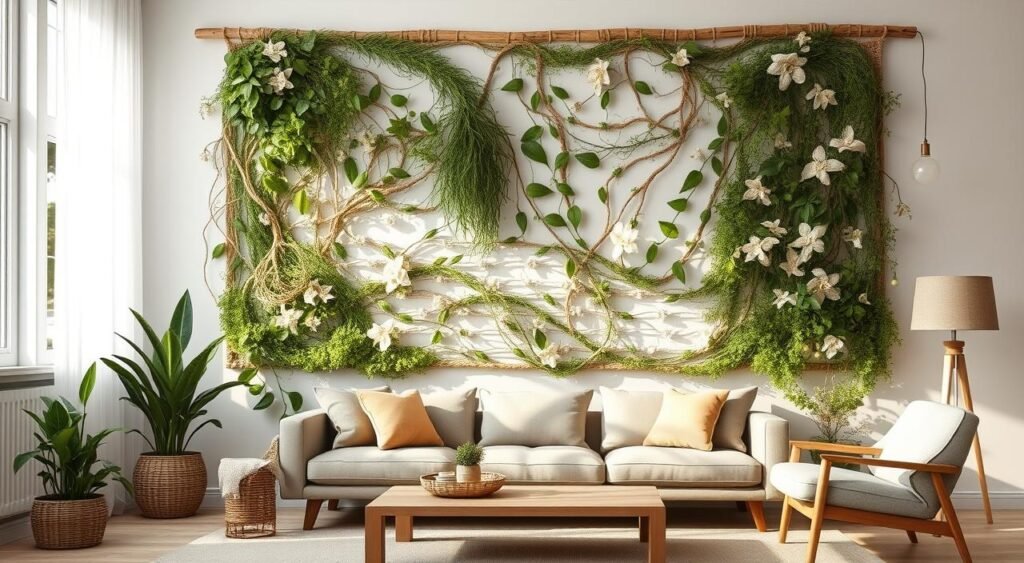
Using Earthy Colors to Create Tranquility
The colors you choose for your home significantly impact the atmosphere. Adopting earthy color palettes lays the groundwork for tranquility. They promote calm and a connection to nature. Colors such as browns, sage greens, and soft blues mirror the natural world, boosting emotional well-being. By understanding color psychology, you can pick hues that not only delight the eye but also bring serenity to your living space.
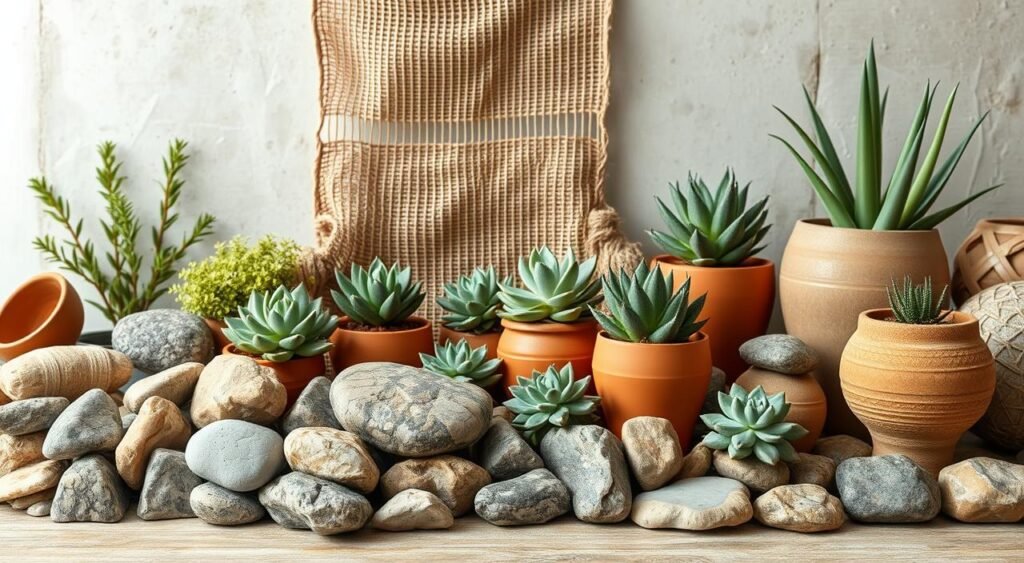
Understanding Color Psychology in Design
Color psychology uncovers how various shades can sway feelings and actions. Warm earthy tones often make a space cozy and inviting. On the other hand, cooler shades can lower stress and encourage relaxation. By integrating these colors into your decor, you subtly shape your space’s mood. Painting walls in serene hues or selecting decor that reflects your love for nature enhances balance in your home. Learn more about minimalist decor and the role of color choices here.
Color Combinations that Reflect Nature
Mixing different earthy tones can intensify the calming effects in your home. Here are some effective color pairings:
| Color Pairing | Effect |
|---|---|
| Soft Beige + Sage Green | Creates a fresh, calming atmosphere reminiscent of nature. |
| Muted Blue + Warm Taupe | Evokes tranquility and stability, ideal for restful spaces. |
| Earthy Brown + Soft Blush | Adds warmth and a touch of elegance, suitable for living areas. |
These pairings reflect the beauty of natural environments, creating a serene atmosphere at home. Exploring these earthy color palettes can result in a more harmonious and welcoming living space.
Enhancing Your Space with Natural Sounds
Incorporating sound into biophilic design is often overlooked, yet it’s essential for our indoor environments. The soft sound of water or birdsong can dramatically change the mood. By adding these calming sounds, you create a space that feels immersive and peaceful.
Sound machines or playlists with natural sounds can bring the outdoors into your home. These calming sounds help reduce stress, leading to relaxation and a stronger connection to nature. Exploring sounds that mirror your favorite natural settings can be very beneficial.

Integrating sound into your home design can greatly enhance your experience and well-being. This small change can significantly impact how you feel in your space. For those interested in biophilic design, learn more about interior design services at this link.
Commit to a Nature Theme for Consistency
Starting a cohesive look in your home begins with a nature theme. This theme not only boosts the aesthetic but also strengthens your bond with the outdoors. When every piece, from furniture to wall colors, reflects nature’s soothing hues, it creates a calm and welcoming space.
To maintain biophilic consistency, choose decor and materials that capture nature’s essence. Wooden accents or soft, earthy textiles are great choices. Each selection should align with your nature theme. This way, your space becomes a sanctuary that mirrors nature’s beauty.
Remember, sound and light are key to tying everything together. Add natural sounds and lighting that mimic the sun’s warmth. This enhances your home’s atmosphere, elevating it and promoting well-being through a genuine connection to nature.
FAQ
What is biophilic design?
Biophilic design merges natural elements, such as plants, light, and organic materials, into indoor spaces. It aims to improve our well-being and foster a connection with nature.
What are the benefits of biophilic design?
Biophilic design offers several benefits. It reduces stress, enhances mood and focus, and improves air quality. It also boosts overall well-being, promoting a healthier lifestyle.
How can I incorporate biophilic design in my home?
To incorporate biophilic design, add indoor plants and use natural materials like wood and stone. Maximize natural light and create calming atmospheres with water features or nature-inspired art.
What are some key principles of biophilic design?
Key principles include maximizing natural light and using organic textures and materials. Blend indoor and outdoor spaces and engage multiple senses for a holistic experience.
How can I choose the right plants for my biophilic interiors?
Choose low-maintenance plants like snake plants, pothos, or fiddle leaf figs. These varieties filter air quality and add visual interest.
Why is natural light important in biophilic design?
Natural light boosts mood and clarity, making it essential in biophilic design. Use large windows or skylights to bring this element into your space.
How can sound enhance my biophilic design?
Adding natural soundscapes, such as flowing water or birdsong, can enhance your home’s sensory experience. It creates a calming, immersive environment.
What materials are best for achieving a biophilic aesthetic?
Natural materials like wood, stone, and bamboo create a cozy atmosphere. Textiles from organic fibers add comfort and enhance the tactile experience.
Can biophilic design be used in offices?
Absolutely! Biophilic design in offices boosts productivity and employee well-being. It integrates natural elements, improves air quality, and creates a pleasant work environment.

AUTHOR: Madeline Turner
Expert in Home Design, Architecture, and Sustainable Living Trends
With over 25 years of experience in interior design and lifestyle writing, Madeline Turner brings a unique blend of creativity, research, and practical know-how to 17Vibes. Her expertise spans home renovations, smart home technology, eco-friendly materials, and modern décor trends. Follow me on LinkedIn
